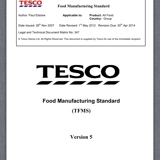Information
-
Document No.
-
Audit Title
-
Client / Site
-
Conducted on
-
Prepared by
-
Location
-
Personnel
10.1 - PERSONAL HYGIENE (BASE)
-
Effective personal hygiene standards must be in place at the site
-
Personal hygiene standards must be documented and followed by all personnel, including visitors and contractors
-
Visitors and contractors must be required to read, understand and accept health, hygiene and safety rules prior to entering the production area
10.2 - HAND WASHING (BASE)
-
Hand washing or sanitising must be completed; (Not exhaustive list)
-
On entry to food handling areas
-
After eating
-
After Smoking
-
After using the toilet
-
After Coughing / sneezing into hands
-
After touching nose or face
-
After Touching or picking up items from the floor
-
After Tying laces
-
After handling unsuitable materials
-
After using ladders
-
Where face masks are worn, staff must wash hands after putting them on
10.2.1 - HAND WASHING (BASE)
-
Non food handlers must wash hands when they commence work but may subsequently use hand sanitiser on entry to non food handling areas e.g. Despatch
10.2.2 - HAND WASHING (MEDIUM)
-
The effectiveness of hygiene procedures with regard to hands must be checked at regular intervals
-
If gloves are worn, hygiene procedures (including frequency of changing) must be in place to ensure that they do not present a risk to product
-
Hand swabs or contact plates are taken and assessed following unannounced but planned programme
-
WGLL - No nail brushes are to be used
10.3 - HYGIENE PROCEDURE (BASE)
-
Personnel must not cough or sneeze over materials or products
-
Spitting must be prohibited in all areas
10.4 - HYGIENE PROCEDURE (BASE)
-
Food and drink must not be consumed in production and storage areas (except water provided by Site / product sampling)
10.5 - PERSONAL MEDICINES (BASE)
-
Procedures must be in place to control the use of personal medicines
10.6 - PLASTER CONTROL (BASE)
-
All cuts and grazes on exposed skin must be covered by a waterproof blue metal detectable plaster / wound dressing provided by the factory
-
Plasters must be issued by an authorised person
-
A log must be kept of issued plasters
-
WGLL - employee initials written onto plaster
-
Procedures must be in place to highlight if a plaster is lost and prompt an investigation to ensure that the plaster has not contaminated product must be completed
10.6.1 - PLASTER CONTROL (MEDIUM)
-
In addition to the metal detectable plaster, a waterproof finger stall or water proof glove must be worn
10.6.2 - PLASTER CONTROL (MEDIUM)
-
There must be plaster reconciliation at the end of the day or shift
10.6.3 - FIRST AID KITS (ASPIRATIONAL)
-
First aid kits contain an inventory of contents, which is checked at defined intervals
-
First aid box contents and quantities are selected so as to minimise the risk of product contamination
10.7 - PERSONAL HYGIENE (BASE)
-
Fingernails must be kept short, clean and unvarnished
-
False fingernails (acrylic or other) must not be permitted<br>
10.8 - PERSONAL HYGIENE (BASE)
-
All personnel must have a good standard of personal hygiene
10.9 - PERSONAL HYGIENE (BASE)
-
Excessive perfume or aftershave must not be worn
10.9.1 - PERSONAL HYGIENE (MEDIUM)
-
False eye lashes or excessive facial make-up must not be worn
10.10 - PERSONAL HYGIENE (BASE)
-
Personal items (e.g. Keys, personal mobile phones, and coins) must not be carried on the person and be taken into production and storage areas (exception: locker keys / ID cards)
-
WGLL - keys used with the factory (eg FB detector reject boxes) are not treated as personal items and attached to key rings or taken home. These are best issued daily as part of the QA kit.
10.11 - PERSONAL HYGIENE (BASE)
-
Procedures must be in place for the breakage / loss of glasses and contact lenses
10.12 - JEWELLERY (BASE)
-
Jewellery must not be worn, with the exception of a single plain band ring (ie. one piece with no stone settings or intricate design)
-
Cuff links and tie pins must be considered as jewellery
-
Watches must not be worn or brought into production and storage areas
-
Rings and studs in exposed parts of the body (including the tongue) must not be worn
-
Personal clothing and fashion accessories must not pose a potential foreign body risk<br>(eg decorative items such as sequins must not be visible on garments, diamanté settings in glasses etc)
10.13 - JEWELLERY (BASE)
-
Additional jewellery may be permitted if it is worn for medical or religious reasons
-
In these circumstances a risk assessment must be completed and the permitted jewellery be strictly controlled
10.13.1 - JEWELLERY (MEDIUM)
-
Permitted medical or religious jewellery is not exposed or pose any food safety risk
-
Such Jewellery is suitably covered by PPE - coat, sleeves and / or gloves














